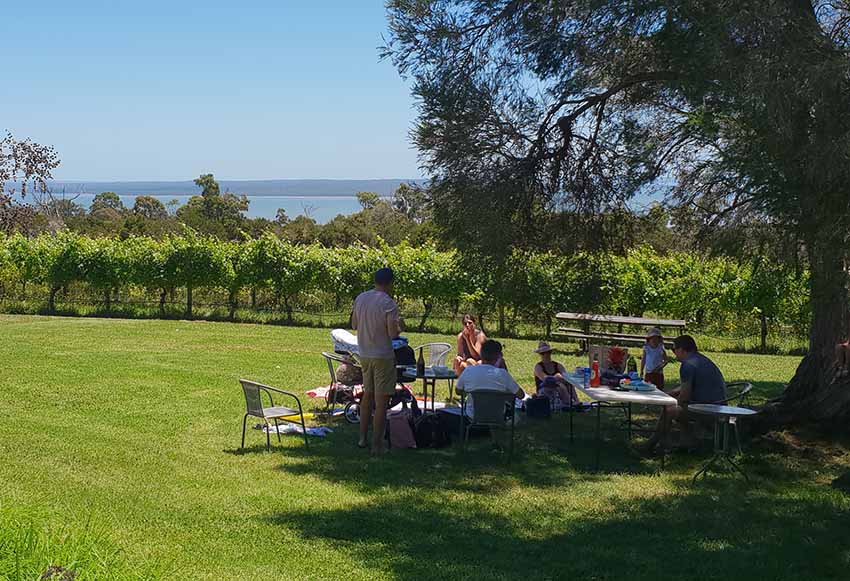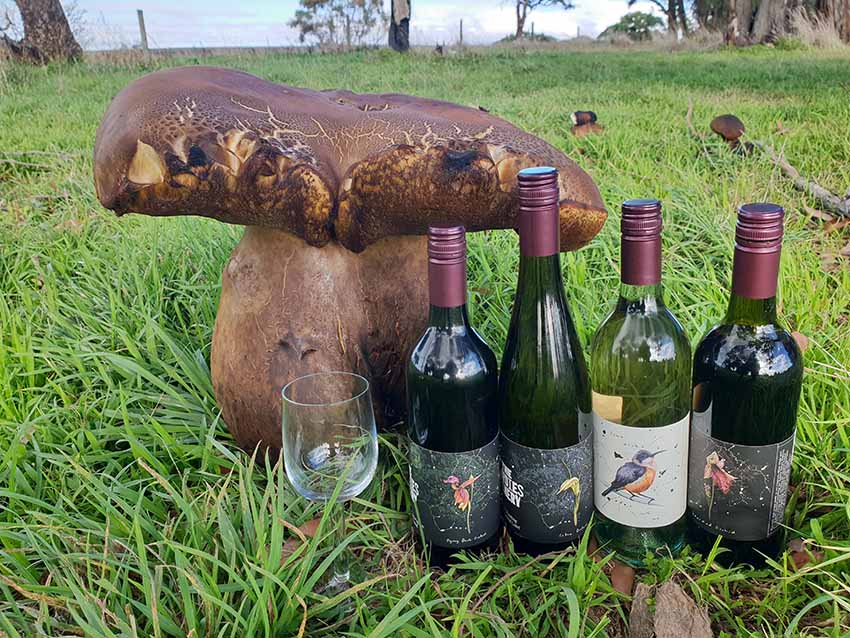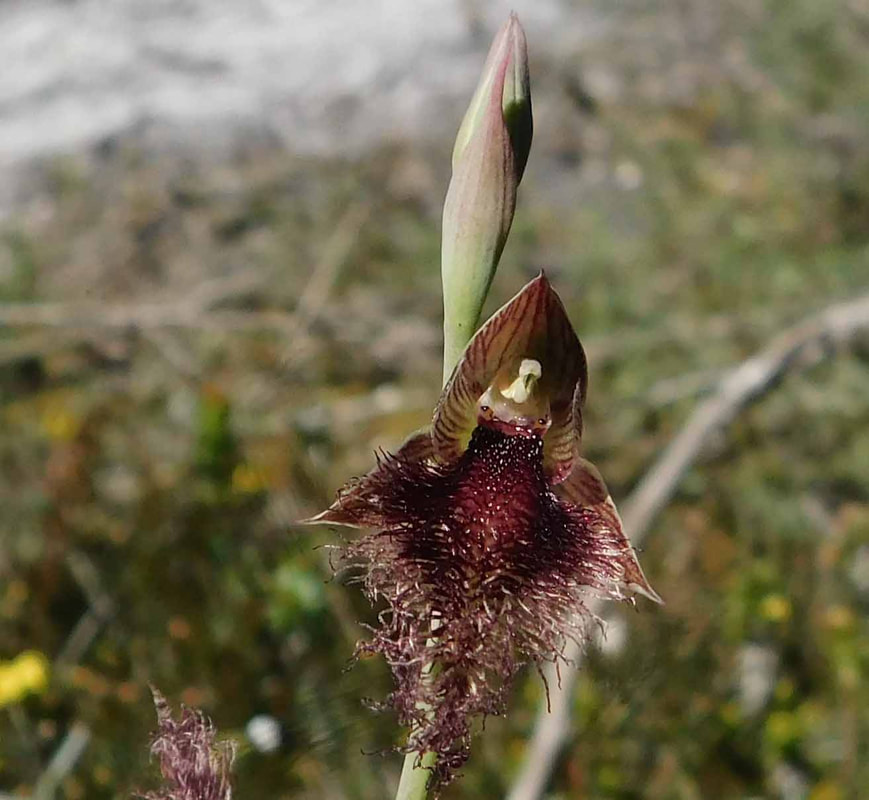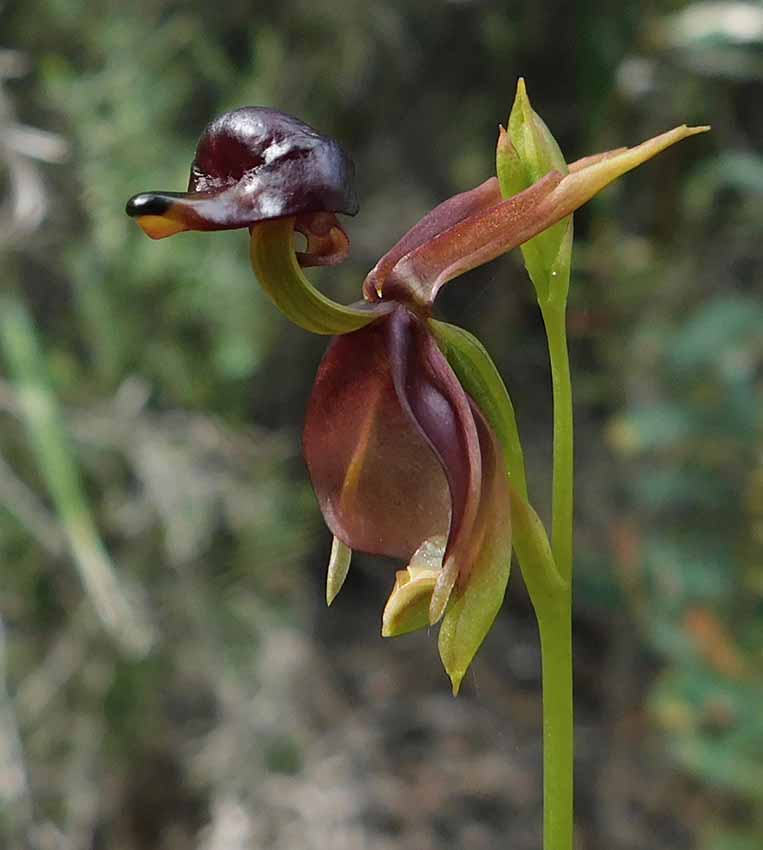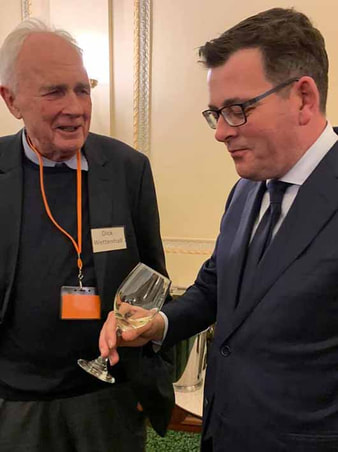 Dick Wettenhall with Daniel Andrews after The Gurdies’ 2017 chardonnay won the Premier’s trophy for best Victorian wine. Despite the gale-force winds, cold wet summers, kangaroos and currawongs, the winery somehow produced many award-winning wines.
Dick Wettenhall with Daniel Andrews after The Gurdies’ 2017 chardonnay won the Premier’s trophy for best Victorian wine. Despite the gale-force winds, cold wet summers, kangaroos and currawongs, the winery somehow produced many award-winning wines. I HAVE just passed an echidna and lace monitor (tree goanna!) meandering along the St Helier roadside, after visiting The Gurdies Nature Conservation Reserve in search of Flying Duck Orchids. At last I have the time for this now that I have sold The Gurdies Winery.
A decade of working in the vineyard and making wine in this spectacular location has provided much to reflect on. As one of Gippsland’s oldest, the vineyard was established by dairy farmer Frank Cutler in 1982. His pioneering efforts led the Western Port Council to engage consultants to formally investigate the potential for commercial viticulture in region in 1987. The availability of cleared land with favourable topography and low frost exposure was viewed as compelling and, in the ensuing three decades, Bass Coast has become the home of several of Gippsland’s most recognised wineries.
The incredible 2013 season delivered warm dry summer weather conditions optimal for red wines, including a gold medal winning Merlot. But seasons with less favourable weather also produced reasonable wine. For example, the very wet and cold 2011 vintage produced an interesting Shiraz, only medium bodied but rich in blackberry and white pepper characters. This wine was particularly well received by European visitors familiar with cool climate Shiraz (Syrah!), but not so much by local customers who generally preferred the relatively full-bodied jammier wines from the hotter 2013, 2015 and 2016 vintages.
The most interesting was the 2017 vintage which produced several major-award-winning wines. Cool and wet early summer conditions were perfect for the slow development of Riesling and Chardonnay. Such conditions are normally less favourable for red grapes. However, an unusually warm and sunny ‘Indian summer’ in April enabled the full ripening of both Shiraz and Cabernet Sauvignon, giving rise to lovely wines with intense pepper, fruit flavours and lingering palate complexity.
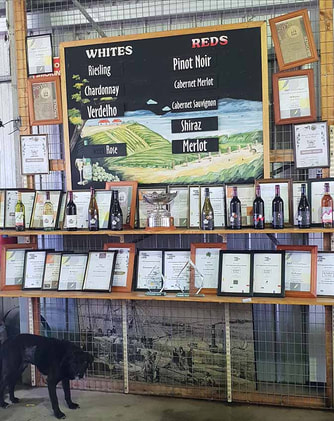 A recalcitrant Basil and some of the winery's many awards.
A recalcitrant Basil and some of the winery's many awards. My final 2020 season was the worst and will no doubt be the subject of nightmares for years to come! Cool and wet summer conditions and lack of sunshine severely retarded grape development, to the extent that most of the Shiraz and Cabernet Sauvignon had to be abandoned. Riesling did better, with slow ripening conditions resulting in the lovely intense fruit flavours and acidity needed for a fine wine. But then disaster struck! The terrible Gippsland fires had driven many birds west in search of food. Never before had so many birds been seen in the vineyard. Parrots, ravens and currawongs inflicted the most damage. But even worse, in the final days before harvest, the sugary juice on the remaining bird-damaged grapes attracted a massive infestation of European wasps, resulting in 80% crop loss. A veritable tragedy for a wine maker who had lost his last chance to achieve the holy grail, the making of the perfect Riesling!
While vineyard events are paramount, the wine maker can do much to improve wine quality. For a start, he/she has a critical role in identifying the narrow grape-picking window for achieving optimal fruit flavour intensities, acidity and sugar content. Also, critically important are the choices of yeasts, or whether to ferment in barrels, or include whole grape bunches in the ferments, or macerate before adding yeasts. Matching oak with individual wine varieties is an acquired art. In this, I received a crash course from Marcus Satchel, after he discovered to his horror my purchase of American oak barrels for making Shiraz… the “never-use-American-oak-for-cool-climate-shiraz” reprimand was delivered with such effect that the barrels remain unused to this day!
I discovered rather belatedly that effective branding was key to wine sales. As a scientist, I assumed that quality wines would sell themselves once tasted and recognised by wine show judges. But despite many awards, wine sales had been generally modest. I had failed to appreciate the importance of the wine label. This changed after wine industry ‘friends’ unsubtly informed me that my self-designed wine labels were “the worst in Gippsland” and did not do justice to award-winning wines! I was introduced to talented designer Sarah Mangion, who embraced the idea of a new wine label based on my photos of native orchids and honeyeaters. A bonus would be the linking of wine branding with my great passion, the incredible wildlife in the nature reserves flanking the vineyard. The new labels were so well received that wine sales increased three-fold!
Even more noteworthy, while working in the vineyard, I developed an acute awareness of the environmental significance of the neighbouring Gurdies and Hurdy Gurdy Nature Conservation Reserves and the important contribution the vineyard makes to the wildlife corridor linking them. This corridor has a broader significance in that it contributes to the overall network of precious remanent forests and other ecosystems surrounding Western Port Bay, as embraced by the Western Port Biosphere Project. This awareness prompted me to spend my final weeks at the winery (assisted by a grant from Melbourne Water and help from the Bass Coast Post editor!) planting native shrubs to provide additional cover for wildlife traversing the vineyard…The need for this was highlighted by the sight of three wedge tail eagles and several other birds of prey circling above while we planted!
Sadly, not all sectors of the community see the need for protecting these precious remanent forests. In this context, I have been appalled to learn of plans to extend sand mining in the Gurdies forest. Thankfully, concerned locals are lobbying the Bass Coast Shire and the State Government to restrict such developments in the future. Now that I am freed from the winery, I will have more time to contribute to this important cause!
